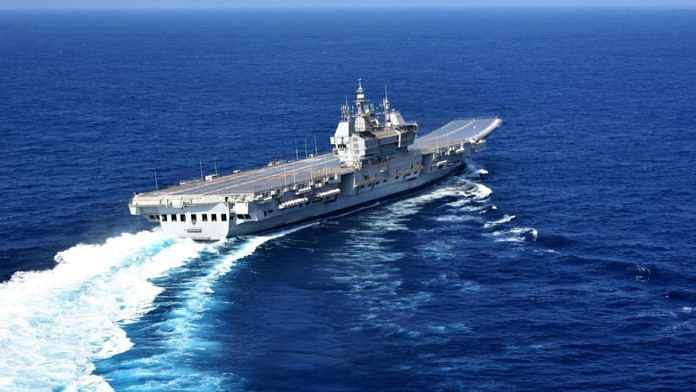New Delhi: The elite fighter pilots of the Indian Navy have not landed on an aircraft carrier for nearly two years and the wait is expected to get longer with the first landing on-board the INS Vikrant likely to take place only early next year, ThePrint has learnt.
The INS Vikramaditya, the other aircraft carrier, has been out of action for the past two years as it is undergoing a repair and refit process. A fire on-board the aircraft carrier in July this year, while it was on a sea trial after refit, added to the delay in its operationalisation, sources in the defence and security establishments said.
It is now expected that the Russian-origin carrier will be made fully operational by the end of this year or early next year.
Even though the naval pilots have been undertaking joint exercises with a number of countries, including the US, they can’t take off from those aircraft carriers because they don’t have a ski-jump, unlike the Vikramaditya and Vikrant.
Sources said that the flight trials on board the newly commissioned INS Vikrant are slated to start this month, but the actual landing of the MiG 29K by the pilots on-board is likely to happen only early next year as the Vikrant would only be fully operational by the end of 2023.
Sources asserted “there has not been any impact” on the training of the naval pilots with them continuing to fly for various operations from land-based assets, practising their ski-jumps from the shore-based test facility (SBTF) at INS Hansa, and on simulators.
They, however, admitted that it is nowhere close to an actual landing on an aircraft carrier, which has its own dynamics.
“The landing and take-off on an actual moving aircraft carrier is drastically different to what it is like on the SBTF or the simulator,” a source said.
They explained that the pilots carry out multiple landings and take-offs on an aircraft carrier to train in different situations, including night landings and different sea states, which is measured by the Douglas Sea Scale using the height of waves and the swell of the sea.
Each pilot, they added, undergoes various grading processes depending on the number of such landings, and this has been impacted over the past two years.
Former Indian navy chief Admiral Arun Prakash (Retd), a naval aviator himself, said that India is fortunate to have the SBTF which enables pilots to maintain and improve their flying skills.
“The Goa SBTF is the only second such facility in the world, with the other being in Crimea. It comes with an exact copy of the carrier landing space with arrestor wires and also the exact ski-jump,” he said.
“Except for the roll, the pitch and the movement of an aircraft carrier, the SBTF gives the same dynamics so that the flying skills are maintained. Not landing on a carrier is not a major concern and is easily surmountable. The pilots will take a week to 10 days max to get back into the deck operations,” he added.
Also Read: After INS Vikrant, India’s next steps should be new carrier, submarines
Vikramaditya refit to take longer
INS Vikramaditya was originally a Russian carrier — Admiral Gorshkov — that was decommissioned in 1996 and later bought by India in 2004 and commissioned in 2013 after refurbishing. Sources said it is undergoing a process called “normal refit”, adding that the Covid pandemic had led to delays in the refit. The fire on board, which affected the blowers and fuel pipes, delayed it further.
The carrier had last undergone a five-month refit in 2018 which cost over Rs 700 crore. It was the second refit the vessel went through since it was commissioned in late 2013.
Asked if it was normal for a ship to undergo such frequent refits, sources explained that there is a cycle of refits for every ship.
In the Indian Navy, a ship undergoes three short refits (which take care of minor repair works) before undergoing a normal refit during which large scale checks are done and every system is overhauled.
After two rounds of normal refit, the ship undergoes what is known as the medium refit, which could entail drastic repair work that also includes dry dock works.
However, sources said Vikramaditya is an old carrier and the Vikrant will not face such drastic repair works for the foreseeable future.
Also Read: BrahMos, INS Vikrant have immense capability but also expose India’s short-sightedness
Price escalation
The deal for Vikramaditya was signed in 2004 by the then NDA government at $974 million, which finally settled at a whopping $2.35 billion in 2010.
The price escalation process became a scandal when pictures of a senior Navy officer, who was closely involved in the Admiral Gorshkov deal, surfaced in 2010 showing him in a compromising position with an unidentified woman. It was seen as part of a Russian honey trap operation.
Incidentally, former Russian Ambassador to India, Vyacheslav Trubnikov, had in 2009 admitted that “the major reason” for the price escalation was that the contract was signed when the Russian company, Sevmash, “badly needed money and wanted to sign the contract, while the Indian side wanted to buy an absolutely modern aircraft carrier at lower than the cheapest price”.
“After the contract was signed (in 2004), both sides began to understand exactly the enormity of the task they had undertaken. But the realisation came a little late,” Trubnikov had said.
(Edited by Theres Sudeep)
Also Read: Putin calls Modi ‘patriot’ for staying neutral on Ukraine, here’s why India needs to balance




